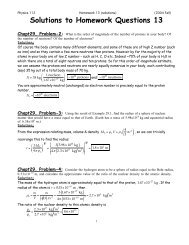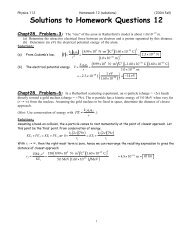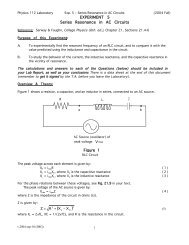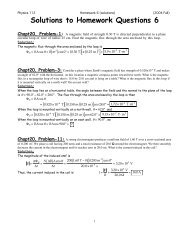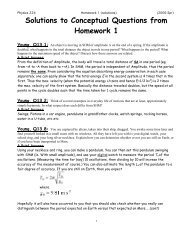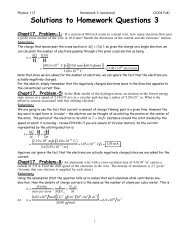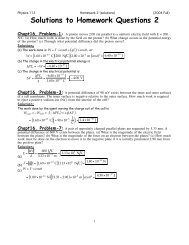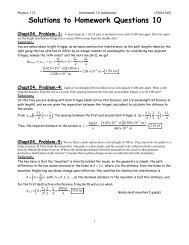Solutions to Homework Questions 1
Solutions to Homework Questions 1
Solutions to Homework Questions 1
You also want an ePaper? Increase the reach of your titles
YUMPU automatically turns print PDFs into web optimized ePapers that Google loves.
Physics 112 <strong>Homework</strong> 1 (solutions) (2004 Fall)<br />
Chapt15, Problem-13: Three point charges are located<br />
at the corners of an equilateral triangle as in Figure P15.13.<br />
Calculate the net electric force on the 7.00 µC charge.<br />
Solution:<br />
The forces on the 7.00 µC charge are shown in the sketch <strong>to</strong><br />
the right. Applying Coulomb’s Law <strong>to</strong> calculate each force,<br />
we get<br />
⎛<br />
F 1<br />
= 8.99× 10 9 N ⋅m 2 ⎞<br />
⎜<br />
⎝<br />
C 2 ⎟<br />
⎠<br />
= 0.503 N<br />
⎛<br />
F 2<br />
= 8.99 ×10 9 N⋅ m 2 ⎞<br />
⎜<br />
⎝<br />
C 2 ⎟<br />
⎠<br />
= 1.01 N<br />
From the superposition principle, we known<br />
ΣF x = ( F 1 + F 2 )cos 60.0° = 0.755 N ,<br />
and ΣF y = ( F 1 − F 2 )sin 60.0° = −0.436 N<br />
( 7.00× 10 −6 C) 2.00 × 10 −6 C<br />
( )<br />
0.500 m<br />
( ) 2<br />
( 7.00 ×10 −6 C) 4.00 × 10 −6 C<br />
( )<br />
0.500 m<br />
( ) 2<br />
So the resultant force on the 7.00 mC charge is<br />
F R = ( ΣF x ) 2 + ( ΣF y ) 2 ⎛ ΣF<br />
= 0.872 N at θ = tan −1 y ⎞<br />
⎜ ⎟ = −30.0° ,<br />
⎝ ΣF x ⎠<br />
or F R = 0.872 N at 30.0° below the + x axis<br />
Chapt15, Problem-16: A charge of 6.00x10 –9 C and a charge of<br />
–3.00x10 –9 C are separated by<br />
a distance of 60.0 cm. Find the position at which a third charge of 12.0 x 10 –9 C can be placed so that the<br />
net electrostatic force on it is zero.<br />
Solution:<br />
The required position is shown in the<br />
sketch <strong>to</strong> the right. Note that this places q<br />
closer <strong>to</strong> the smaller charge, which will<br />
allow the two forces <strong>to</strong> cancel. Applying Coulmob’s<br />
Law, and requiring that F 6 = F 3 gives<br />
k e ( 6.00 nC )q<br />
( x + 0.600 m ) 2 = k e( 3.00 nC)q<br />
x 2 , or 2 x 2 = ( x + 0.600 m ) 2<br />
Solving for x gives the equilibrium position as<br />
x = 0.600 m = 1.45 m beyond the - 3.00 nC charge<br />
2 − 1<br />
3







